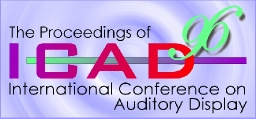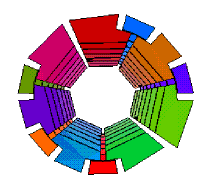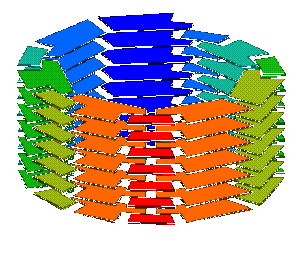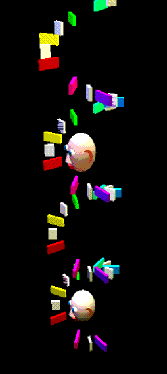
 |
Design of a Helical Keyboard |

|
IntroductionInspired by the cyclical nature of octaves and the helical structure of a scale (Shepard 1982, 1983), we prepared a model of a piano-style keyboard (prototyped in Mathematica) and then geometrically warped it into a left-handed helical configuration: one octave/revolution with pitch mapped to height. The upper frequency keys appear higher on the helix, suggesting a parsimonious left-handed chirality and positioning ascending notes before the listener in a left-right order. Our model is being imported, via the dxf file format, into (Open Inventor/) VRML, where MIDI events, realtime or sequenced, can drive the model. The stream, synthesized by a Roland Sound Module and spatialized by a heterogeneous spatial-sound backend (including the Crystal River Engineering Acoustetron II and the Pioneer Sound-Field Control Speaker-Array System), automatically directs the sound of the notes with respect to sinks (avatars of the human user) in the helix tube. Currently a work-in-progress, this model should be fully functional within the next few months.
Alternative Coloring SchemesBesides the traditional ebony and ivory, possible coloring schemes for the helical keyboard include a color wheel (Figure 1a), wireframing of white keys for visualization of pentatonic music, and a dynamic color map (Figure 1b) compatible with chromastereoptic eyewear (find another version at http://www.u-aizu.ac.jp/~mcohen/spatial-media/helical-keyboard/).
  
Normalizing Octaves through Multiple SinksOur system allows separate audition of harmony and melody, played by the left and right hands, respectively, on a normal keyboard. A single head inside the helix (near the base, for instance) might easily distinguish the position of the harmony, but the melodic notes would seem to originate from the upper pole. Perhaps the most exotic feature of the helical keyboard is the ability to fork one's presence (Cohen 1995; Cohen and Koizumi 1995), which replicates subject instead of object, by installing multiple sinks arbitrarily throughout the virtual scene (Figure 2)
ReferencesMichael Cohen and Nobuo Koizumi. (1995). Audio windows for virtual concerts II: Sonic cubism. In Video Proceedings of ICAT/VRST: Int. Conf. Artificial Reality and Tele-Existence/Conf. on Virtual Reality Software and Technology. Makuhari, Chiba, Japan: Society of Instrument and Control Engineers. Diana Deutsch. (August 1992). Paradoxes of musical pitch. Scientific American. 70--75. Roger N. Shepard. (1982). Structural representations of musical pitch. In The Psychology of Music. Academic Press. Roger N. Shepard. (1983). Demonstrations of circular components of pitch. J. Aud. Eng. Soc. 31(9), 641-649.
|
